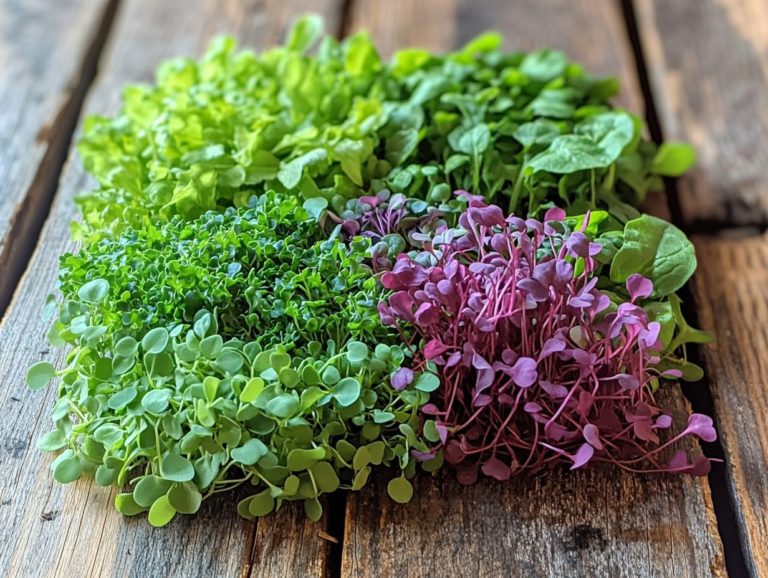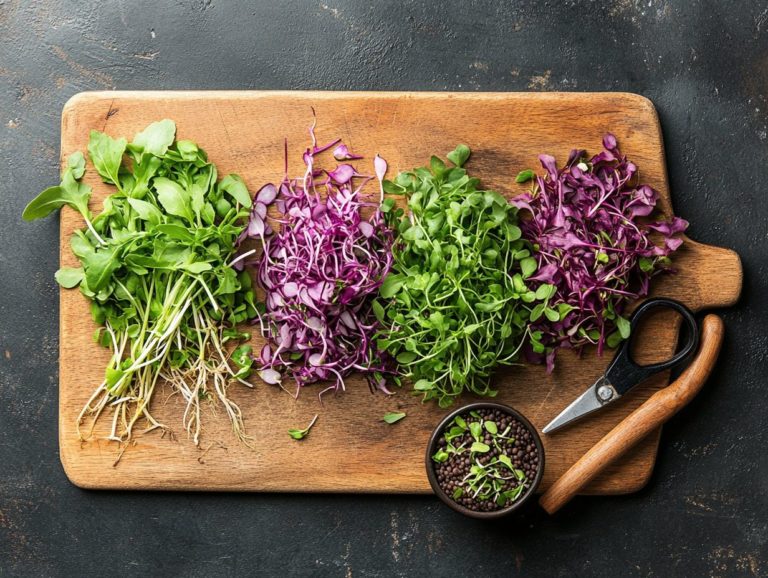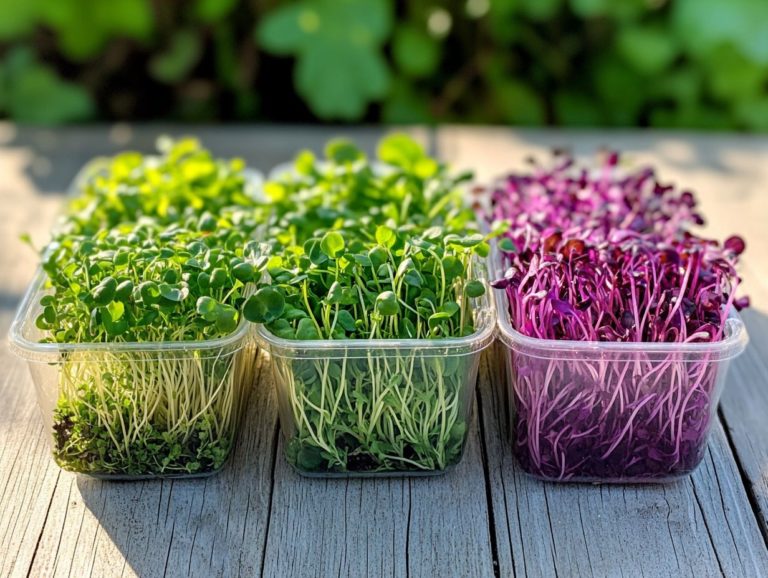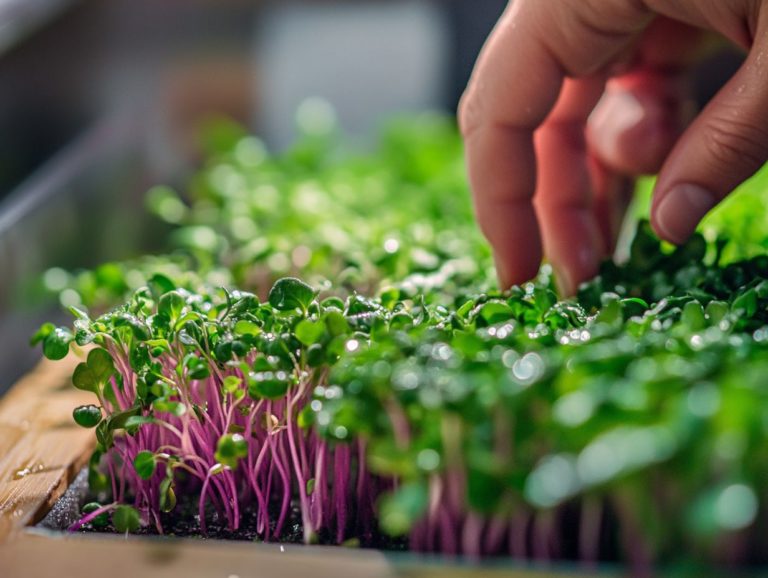Microgreens: A Solution for Nutrient Deficiency
Microgreens are not just adorable; they are a powerhouse of flavor and nutrition that can transform your meals and boost your health! These vibrant and nutritious additions to your diet provide a remarkable burst of flavor and health benefits from those tiny leaves.
These miniature plants are not just cute; they pack significantly higher nutrient levels than their fully grown counterparts. This makes them a fantastic weapon against nutrient deficiencies.
Dive into the fascinating world of microgreens, exploring their impressive nutritional value, common nutrient deficiencies, and the ways these little greens can enhance your overall well-being. You’ll uncover tips for cultivating your own microgreens and discover delicious recipe ideas to seamlessly incorporate them into your meals.
Embrace the world of microgreens and see how they can elevate your health!
Contents
- Key Takeaways:
- What are Microgreens?
- Nutritional Value of Microgreens
- Causes and Effects of Nutrient Deficiency
- How Microgreens Can Help
- Growing and Incorporating Microgreens into Your Diet
- Frequently Asked Questions
- What are microgreens and how can they help with nutrient deficiency?
- What nutrients do microgreens provide?
- How do microgreens compare to other greens?
- Can microgreens be grown at home?
- What types of microgreens are best for addressing nutrient deficiency?
- Are there any precautions to take when consuming microgreens?
Key Takeaways:
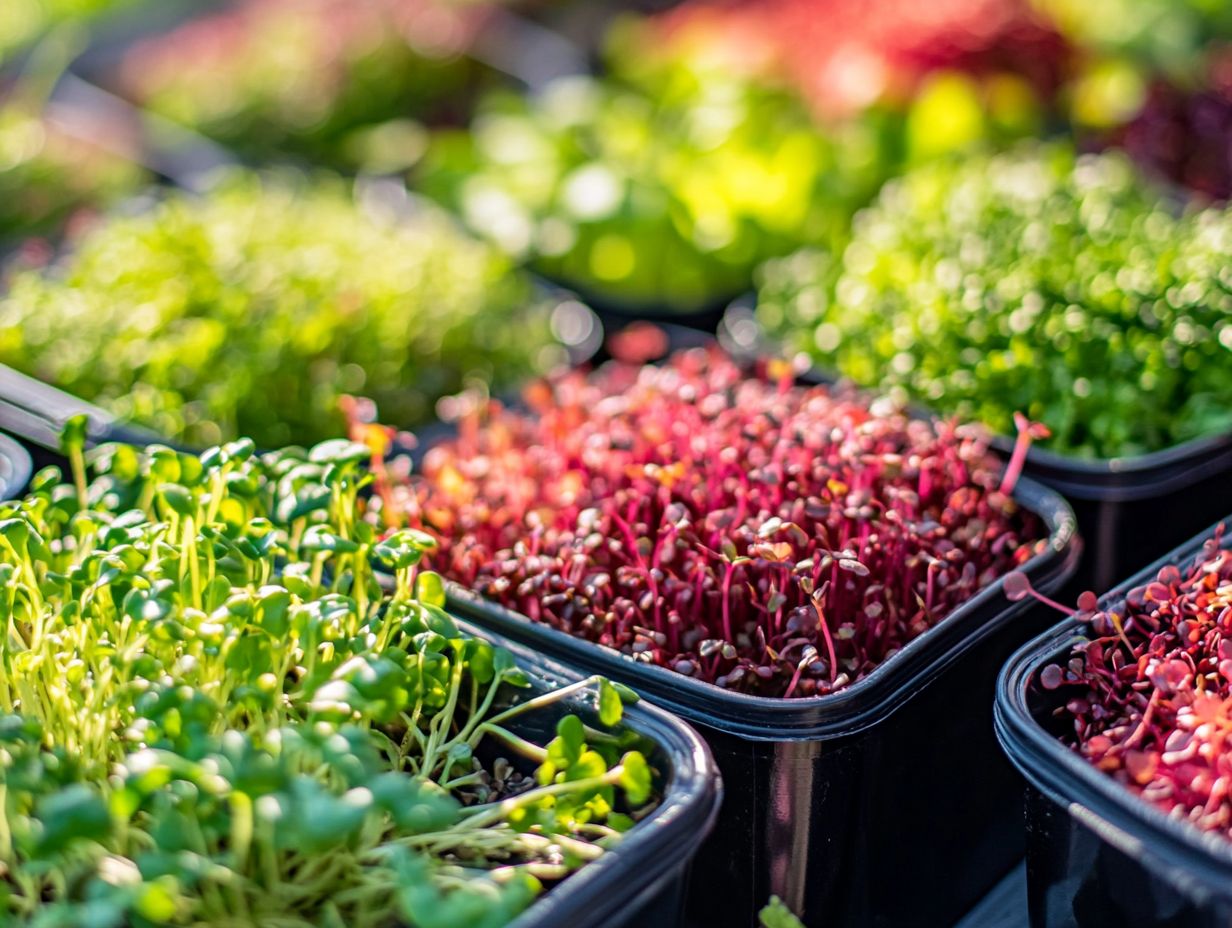
- Microgreens are packed with essential vitamins and minerals.
- They can offer up to 40 times more nutrients than mature plants!
- Add them to your meals for a boost of vitamins A, C, E, iron, calcium, and potassium.
What are Microgreens?
Microgreens are the young, edible plants you encounter at the initial stages of growth, usually just after the first true leaves have emerged. They stand out as nutrient powerhouses compared to their fully matured vegetable counterparts, delivering concentrated nutrients that offer a wealth of health benefits.
As noted by the Cleveland Clinic and nutritionist Kayla Kopp, these tiny greens can elevate your healthy diet. Rich in antioxidants and natural compounds found in plants that are good for your health, they make a superb addition to your meals, contributing to your overall wellness. For more on their benefits, check out the science behind microgreens and health.
Definition and Benefits
The health benefits of microgreens go far beyond their eye-catching colors and delightful flavors; they serve as a great source of antioxidants and phytonutrients.
Research has shown that these nutrient-packed young plants are particularly adept at lowering risk factors for various chronic diseases. For instance, a study published in *Nutrition Reviews* revealed that microgreens can enhance heart health by helping to reduce cholesterol levels and manage blood pressure. With their impressive concentrations of vitamin K and polyphenols, they also support cardiovascular function and play a role in preventing Type 2 diabetes, as noted by nutrition experts. Additionally, understanding the role of microgreens in healthy eating can further highlight their benefits.
Microgreens also sharpen cognitive function; certain varieties contain compounds beneficial in warding off neurodegenerative diseases. By adding these tiny greens to your meals, you’re setting the stage for significant improvements in your overall well-being and longevity. Discover more about unlocking the antioxidant power of microgreens to enhance your diet.
Nutritional Value of Microgreens
Microgreens are incredibly nutritious, frequently outshining their fully grown vegetable counterparts in terms of essential vitamins, minerals, and antioxidants.
Comparison to Mature Plants
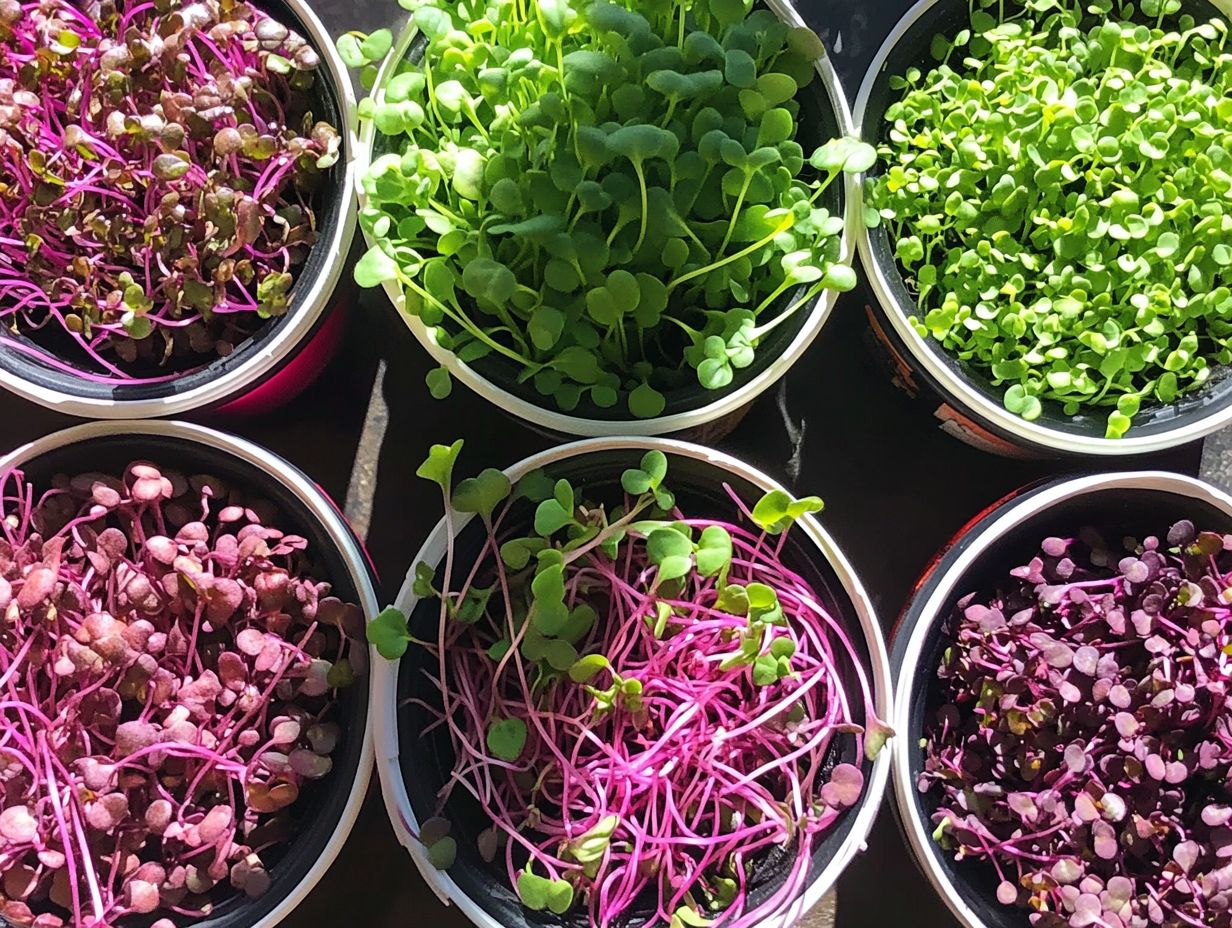
Compared to mature vegetables, microgreens are more nutritious, offering a concentrated source of nutrients and beneficial compounds like polyphenols.
These tiny powerhouses, harvested at an early stage, deliver a remarkable punch of vitamins, minerals, and antioxidants that often outshine their fully grown counterparts. For example, while mature broccoli boasts impressive levels of vitamin K, its microgreen version contains significantly higher concentrations of this essential vitamin, effectively boosting your immune system and supporting overall health. For more information, explore the nutritional benefits of common microgreens.
Such distinctions underscore the nutritional benefits and highlight the versatility of incorporating these vibrant greens into your daily meals for an extra healthful boost, as detailed in microgreens: nature’s vitamins in a tiny package.
Causes and Effects of Nutrient Deficiency
Nutrient deficiencies can result in a range of health complications, from iron deficiency to elevated cholesterol levels. These issues can heighten your risk of heart disease and Type 2 diabetes, ultimately taking a toll on your overall wellbeing.
Common Deficiencies and Health Impacts
Common deficiencies in nutrients like iron and zinc can lead to significant health consequences, including fatigue and a weakened immune system. They also increase the risk of chronic diseases such as heart disease.
These deficiencies are concerning, impacting millions of people around the globe. For example, the World Health Organization highlights that low iron levels affect over 1.6 billion individuals, with women and children being particularly vulnerable.
Mineral shortages can worsen health issues. Damage from harmful molecules called free radicals can also increase these risks, making antioxidants essential allies in your wellness journey.
Microgreens, often brimming with vitamins A, C, and E, are powerful sources of antioxidants that help combat these detrimental effects. Registered dietitians point out that adding microgreens to your diet can not only boost nutrient intake but also enhance your body’s ability to fight off illness and support cardiovascular health. Additionally, they are known for their benefits related to skin health, as highlighted in microgreens: the secret to healthy skin.
How Microgreens Can Help
Incorporating microgreens into your diet can truly elevate your nutritional intake and empower you to embrace a healthier lifestyle, while also aiding in diabetes management. These tiny powerhouses are abundant in iron and antioxidants, making them a remarkable addition to your meals.
Key Nutrients and Their Sources
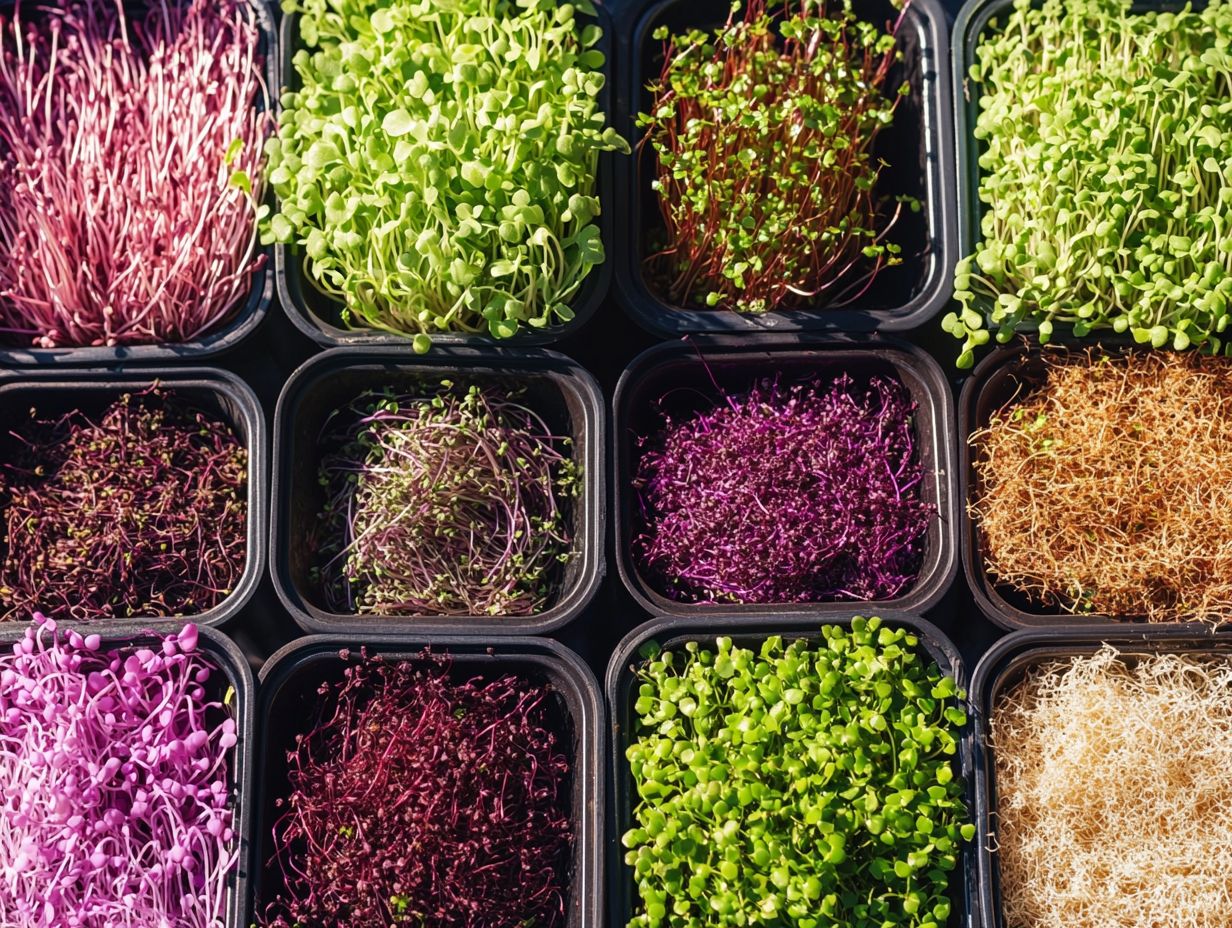
Microgreens are a powerhouse of essential nutrients, brimming with vitamin c, vitamin k, and a variety of antioxidants that elevate your health and wellness.
These miniature versions of vegetables and herbs deliver concentrated doses of nutrients that can dramatically enhance your diet. Take broccoli microgreens, for example; they are loaded with sulforaphane, a compound that may help fight cancer. Likewise, red cabbage microgreens are a fantastic source of vitamin K, crucial for maintaining bone health and supporting blood clotting. Including various microgreens can improve your meals and align with the role of microgreen varieties in plant-based diets.
But it doesn’t stop there. The antioxidants found in these tiny greens play a vital role in combating oxidative stress, which has been linked to chronic diseases such as heart disease and diabetes. By incorporating microgreens into your daily meals, you not only infuse vibrant flavor but also boost your immune function and enhance your overall vitality, reaping the benefits of eating microgreens daily.
Growing and Incorporating Microgreens into Your Diet
Growing microgreens at home offers an exciting way to improve your meals. By incorporating these nutritious foods into your diet, you enhance your meals and introduce a vibrant spectrum of flavors, creating a beautiful array of ‘vegetable confetti’ that livens up any dish.
Tips for Growing and Preparing Microgreens
To successfully cultivate and prepare microgreens, begin with high-quality seeds and select an appropriate growing medium. Ensure you provide the right balance of light and moisture for optimal health benefits.
The choice of soil is essential; a lightweight mix rich in organic matter typically delivers the best outcomes. Once you’ve sown your seeds, ensure consistent watering, using a gentle spray to avoid displacing them.
Light plays a pivotal role as well these tiny plants flourish under bright, indirect sunlight or with fluorescent grow lights for about 12 to 16 hours each day.
When incorporating microgreens into your meals, they seamlessly elevate salads, sandwiches, or smoothies, enhancing both flavor and nutrition.
By adding these nutritious greens to your diet, you not only boost your meals but also increase your intake of essential vitamins and minerals, supporting a well-rounded and healthy lifestyle.
Don’t miss out on the benefits of microgreens! Start adding them to your meals today for better health!
Recipes and Meal Ideas
Incorporating microgreens into your meals is effortless and delightful. These tiny powerhouses bring vibrant flavors and essential nutrients.
Microgreens not only elevate the taste of salads and sandwiches but also deliver a wealth of vitamins and antioxidants. Picture zesty radish microgreens adding a peppery kick to your classic garden salad.
Try sprinkling a handful of sunflower microgreens over your morning smoothie bowl for an extra layer of nutrition. Embracing these greens can encourage healthier eating habits.
Frequently Asked Questions

What are microgreens and how can they help with nutrient deficiency?
Microgreens are young, edible plants harvested when only a few inches tall. They are packed with nutrients and can solve nutrient deficiencies effectively.
What nutrients do microgreens provide?
Microgreens are full of vitamins, minerals, and antioxidants. Common nutrients include vitamin C, vitamin K, potassium, and iron.
How do microgreens compare to other greens?
Microgreens often contain higher levels of certain nutrients than mature plants. For instance, red cabbage microgreens have six times more vitamin C than mature red cabbage.
Can microgreens be grown at home?
Yes, microgreens are easy to grow at home with minimal space and equipment. All you need is a shallow tray, soil, and water.
Start growing microgreens today and enjoy their amazing health benefits!
What types of microgreens are best for addressing nutrient deficiency?
Microgreens are packed with nutrients! Some varieties provide even more specific benefits.
For instance, broccoli microgreens are rich in sulforaphane. This powerful compound may help reduce inflammation and fight cancer.
Fenugreek microgreens are also beneficial. They might help the body process sugar more effectively.
Are there any precautions to take when consuming microgreens?
When enjoying microgreens, food safety is crucial. Remember to wash them thoroughly and avoid any that look wilted or moldy.
For the best health, try to eat a variety of microgreens. This can support brain health and may lower the risk of Alzheimer s disease!

